
Lundi 07 décembre 2020 - à 21h05 - France 3
Disponible en replay jusqu'au 14/12/2020
Monroe et Miller :
Deux couples à Hollywood
/image%2F1211268%2F20240504%2Fob_d6bf56_banner-mm-2024-05-spring-summer-1.jpg)

Lundi 07 décembre 2020 - à 21h05 - France 3
Disponible en replay jusqu'au 14/12/2020
captures de la Bande Annonce
© All images are copyright and protected by their respective owners, assignees or others.
Yves Montand et Marilyn Monroe : les secrets d'une romance passionnée
07/12/2020 | par Thomas Colpaert - en ligne sur programme-tv.net
Au printemps 1960, Yves Montand et Marilyn Monroe tournent ensemble Le Milliardaire. Mariés et stars dans leur pays, tous deux entament une étonnante liaison, détaillée dans le documentaire Signoret et Montand, Monroe et Miller : deux couples à Hollywood.
C'est l'histoire de deux stars, deux immenses talents regrettés. En France comme aux Etats-Unis, Yves Montand et Marilyn Monroe ont laissé une trace indélébile. Le premier dans des rôles aussi variés que La Folie des grandeurs, où il doit résister au charme ravageur d'Alice Sapritch, ou le diptyque évènement Jean de Florette - Manon des sources ,films cultes des années 80 adaptés de l'oeuvre de Marcel Pagnol. La seconde icône éternelle, glamour dans Certains l'aiment chaud , impressionnante dans Les Désaxés, film maudit entré dans la légende. Deux personnalités fortes, dont la rencontre, détaillée dans le documentaire Signoret et Montand, Monroe et Miller : deux couples à Hollywood diffusé sur France 3, a fait des étincelles.
Yves Montand - Simone Signoret, Marilyn Monroe - Arthur Miller : deux couples qui se rapprochent
C'est à la fin des années 50 que les deux acteurs se rapprochent l'un de l'autre. Ou plus précisément leurs couples. Yves Montand est en effet marié depuis près de dix ans à Simone Signoret, interprète inoubliable de Casque d'Or (1952). Marilyn Monroe de son côté s'est unie en 1956 avec le dramaturge Arthur Miller, auteur des Sorcières de Salem et de Mort d'un commis voyageur. La rencontre se passe en 1959, alors qu'Yves Montand, également chanteur, donne une représentation à Broadway. Présente dans la salle, Marilyn est conquise par ce frenchy, et organise un dîner à quatre. Les deux couples s'entendent à merveille, différents et pourtants semblables dans leur sensibilité artistique, mais également leurs opinions politiques, ancrés à gauche. L'occasion est belle pour Yves Montand, qui rêve de faire carrière à Hollywood, de partager l'affiche d'un film avec Marilyn Monroe. Ce sera un an plus tard, dans Le Milliardaire (Let's make love en version originale).
Un premier baiser "tendre, superbe" entre Yves Montand et Marilyn Monroe
Au printemps 1960, les deux couples s'installent côte à côte dans le Beverly Hills Hotel et cohabitent presque ensemble pendant plusieurs mois. Fin avril, Yves Montand et Marilyn Monroe se retrouvent plusieurs semaines seuls, Simone Signoret étant repartie travailler en Europe alors que le couple que la comédienne forment avec Arthur Miller bat de l'aile. La simple complicité amicale et de travail les deux partenaires à l'écran se transforme en relation amoureuse. "Mes lèvres dérapent, je suis à moitié sonné", raconte Yves Montand à propos de leur premier baiser, "tendre, superbe". L'idylle dure plusieurs semaines et au bout d'un mois, la presse américaine révèle l'affaire, au grand dam de Simone Signoret, oscarisée l'année précédente pour Les Chemins de la haute ville. Si Marilyn Monroe n'a jamais parlé de cette romance, Yves Montand l'a évoquée par des mots détournés lors de plusieurs entretiens. Leur histoire se termine à la fin du tournage du Milliardaire.
© All images are copyright and protected by their respective owners, assignees or others.

Making the Image: Eve Arnold’s Portrait of a Pensive Marilyn Monroe
| en ligne sur magnumphotos.com
Arnold's grandson explores her writings on the making of the famed image, and shares previously unseen contact sheets from the Nevada set of The Misfits
Le petit-fils d'Arnold explore ses écrits sur la création de la célèbre image et partage des planches contacts inédites du tournage au Nevada de The Misfits

Marilyn Monroe in the Nevada desert going over her lines for a difficult scene
she is about to play with Clarke Gable in the film 'The Misfits' by John Huston.
Nevada, USA. 1960. © Eve Arnold | Magnum Photos
Contact sheets: direct prints of sequences of negatives were – in the pre-digital era – key for photographers to be able to see what they had captured on their rolls of film. They formed a central part of editing and indexing practices, and in themselves became revealing of photographers’ approaches: the subtle refinements of the frame, lighting and subject from photograph to photograph, tracing the image-maker’s progress toward the final composition that they ultimately saw as their best. There is a voyeuristic aspect to looking at a contact sheet also: one can retrace the photographer’s movements through time and space, tracking their eye’s smallest twitches from left to right as their attention is drawn. It is as if one were inside their head, offered a privileged view through their very eyes from the front row of their brain.
Planche Contact: l'impression directe de séquences de négatifs était - à l'ère pré-numérique - la clé pour que les photographes puissent voir ce qu'ils avaient capturé sur leurs pellicules. Ils formaient une partie centrale des pratiques d'édition et d'indexation, et devenaient en eux-mêmes révélateurs des approches des photographes: les raffinements subtils du cadre, de l'éclairage et du sujet de la photographie à la photographie, retraçant les progrès du créateur d'images vers la composition finale qu'ils ont finalement vue comme leur meilleur. Il y a aussi un aspect voyeuriste à regarder une planche contact: on peut retracer les mouvements du photographe à travers le temps et l’espace, en suivant les moindres contractions de son œil de gauche à droite au fur et à mesure que son attention est attirée. C'est comme si on était à l'intérieur de leur tête, offrait une vue privilégiée à travers leurs yeux mêmes du premier rang de leur cerveau.
As Kristen Lubben wrote in her introduction to the book, Magnum Contact Sheets, first published in 2011 by Thames and Hudson:
“Unique to each photographer’s approach, the contact is a record of how an image was constructed. Was it a set-up, or a serendipitous encounter? Did the photographer notice a scene with potential and diligently work it through to arrive at a successful image, or was the fabled ‘decisive moment’ at play? The contact sheet, now rendered obsolete by digital photography, embodies much of the appeal of photography itself: the sense of time unfolding, a durable trace of movement through space, an apparent authentication of photography’s claims to transparent representation of reality.”
Comme Kristen Lubben l'a écrit dans son introduction au livre, Magnum Contact Sheets, publié pour la première fois en 2011 par Thames et Hudson:
«Unique à l'approche de chaque photographe, le contact est un enregistrement de la façon dont une image a été construite. Était-ce une mise en place ou une rencontre fortuite? Le photographe a-t-il remarqué une scène avec du potentiel et l'a-t-il travaillé avec diligence pour arriver à une image réussie, ou le légendaire «moment décisif» était-il en jeu? La feuille de contact, maintenant rendue obsolète par la photographie numérique, incarne une grande partie de l'attrait de la photographie elle-même: le sens du temps qui se déroule, une trace durable de mouvement à travers l'espace, une authentification apparente des revendications de la photographie à une représentation transparente de la réalité."
Below, Michael Arnold – grandson of Eve Arnold, and a representative of the Eve Arnold Estate – writes about the making of the (above) famed image of a concerned Marilyn Monroe, seemingly isolated on the set of The Misfits. Offering personal insight and archival context on the star’s troubled time on set, he also shares previously unseen contact sheet images from the work Arnold made during the film’s production.
Ci-dessous, Michael Arnold - petit-fils d'Eve Arnold, et un représentant du domaine Eve Arnold - écrit sur la création de la célèbre image (ci-dessus) d'une Marilyn Monroe concernée, apparemment isolée sur le tournage de The Misfits. Offrant un aperçu personnel et un contexte d’archivage sur le temps troublé de la star sur le plateau, il partage également des images de planches de contact inédites du travail réalisé par Arnold pendant la production du film.
As a photographer, Eve Arnold was known for getting beneath the surface of her subjects, for capturing something of the real person hidden behind the persona.
In this well-known picture, actress Marilyn Monroe is memorizing her lines on the set of the film The Misfits. Monroe found it very difficult to memorize her lines and felt insecure about this. Because of the close bond Eve gained from working with Marilyn over several years she was able to capture the fragility and vulnerability behind her usually confident, and instantly recognizable exterior.
En tant que photographe, Eve Arnold était connue pour se cacher sous la surface de ses sujets, pour capturer quelque chose de la personne réelle cachée derrière le personnage.
Dans cette image bien connue, l'actrice Marilyn Monroe mémorise ses lignes sur le tournage du film Les Misfits. Monroe a eu beaucoup de mal à mémoriser ses lignes et se sentait mal à l'aise à ce sujet. En raison du lien étroit qu'Eve a noué en travaillant avec Marilyn pendant plusieurs années, elle a pu capturer la fragilité et la vulnérabilité derrière son extérieur habituellement confiant et immédiatement reconnaissable.
Eve describes this fragility in her book, In Retrospect:
“My most poignant memory of Marilyn is of how distressed, troubled and still radiant she looked when I arrived in Nevada to work on The Misfits. She asked immediately how she looked, and she wanted and needed reassurance. It was four years since we had worked together, and she looked into my eyes for a long moment to make sure she could still trust me. Then she drew her breath, sighed and said, “I’m thirty-four years old. I’ve been dancing for six months [on Let’s Make Love]. I’ve had no rest, I’m exhausted. Where do I go from here ?” She was not asking me – she was asking herself. This was less than a year before she died. It occurred to me then that when she had lived with the fantasy of Marilyn that she had created, that fantasy had sustained her, but now the reality had caught up with her and she found it too much to bear.”
Eve décrit cette fragilité dans son livre, In Retrospect:
«Mon souvenir le plus émouvant de Marilyn est de voir à quel point elle avait l'air affligée, troublée et toujours radieuse quand je suis arrivée au Nevada pour travailler sur The Misfits. Elle a immédiatement demandé à quoi elle ressemblait et elle voulait et avait besoin d'être rassurée. Cela faisait quatre ans que nous avions travaillé ensemble, et elle m'a regardé dans les yeux pendant un long moment pour s'assurer qu'elle pouvait encore me faire confiance. Puis elle retint son souffle, soupira et dit: «J'ai trente-quatre ans. J'ai dancé pendant six mois [sur Let’s Make Love]. Je n'ai pas eu de repos, je suis épuisée. Où dois-je aller d'ici ? » Elle ne me demandait pas à moi - elle se posait la question. C'était moins d'un an avant sa mort. Il m'est alors venu à l'esprit que lorsqu'elle avait vécu avec le fantasme de Marilyn qu'elle avait créé, ce fantasme l'avait soutenue, mais maintenant la réalité l'avait rattrapée et elle trouvait cela trop difficile à supporter."
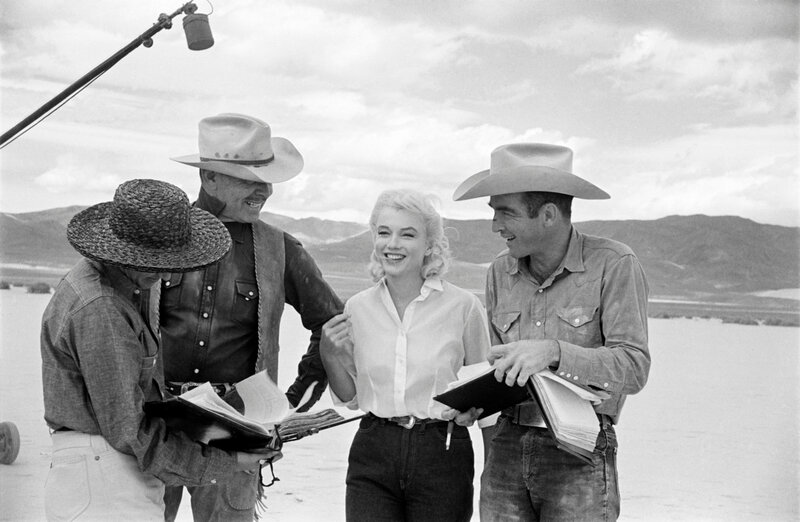
Clark Gable, Marilyn Monroe, Montgomery Clift on the set of 'The Misfits'.
1960. Reno. Nevada. USA. © Eve Arnold | Magnum Photos
Eve spoke further about the filming of The Misfits in a BBC documentary, Eve and Marilyn:
“…When Arthur [Miller] met Marilyn he then rewrote the story. It then became the basis for the film called The Misfits. It had Clarke Gable in the lead. It had Marilyn as the female lead. It had Montgomery Clift, Ely Wallach. It was meant to be exquisitely made. It was meant to be a small statement but very serious. And it was meant to bring Marilyn forward as a very serious actress. And this was Miller’s valentine to Marilyn. The marriage was already over but what he had wanted to do with it was to give her a gift.
She adored all of it. She loved the attention and she loved these very handsome men. What she didn’t like was the fact that they were all such polished actors. When they kept changing lines they would just reel them off and they would be word-perfect. And she would have difficulty because a) she didn’t have the training, and b) because she was troubled and it was difficult to remember the lines when she was going through a trying time.
She was ill at the time and she was disturbed. She had twice taken an overdose of sleeping tablets. I’m sure by accident because her big enemy was that she couldn’t sleep. And so, nights she would take two pills and then two more pills and then forgetting, she’d wake up and be muzzy, and in the morning she could hardly find her way around.”
Eve a parlé plus en détail du tournage de The Misfits dans un documentaire de la BBC, Eve et Marilyn:
«… Quand Arthur [Miller] a rencontré Marilyn, il a ensuite réécrit l'histoire. C'est ensuite devenu la base du film intitulé The Misfits. Il avait Clarke Gable en tête. Il avait Marilyn comme femme principale. Il y avait Montgomery Clift, Ely Wallach. Il était censé être fait de manière exquise. C'était censé être une petite déclaration mais très sérieuse. Et cela visait à faire de Marilyn une actrice très sérieuse. Et c'était la Saint-Valentin de Miller à Marilyn. Le mariage était déjà terminé mais ce qu'il avait voulu en faire, c'était lui faire un cadeau.
Elle adorait tout cela. Elle a adoré l'attention et elle a adoré ces très beaux hommes. Ce qu’elle n’a pas aimé, c’était le fait qu’ils étaient tous des acteurs aussi raffinés. Quand ils continuaient à changer de lignes, ils les enroulaient simplement et ils étaient parfaits. Et elle aurait des difficultés parce que a) elle n’a pas eu la formation, et b) parce qu’elle était troublée et qu’il était difficile de se souvenir des répliques quand elle traversait une période difficile.
Elle était malade à l'époque et elle était perturbée. Elle avait pris deux fois une surdose de somnifères. J'en suis sûre par accident car son grand ennemi était qu'elle ne pouvait pas dormir. Et donc, les nuits où elle prenait deux pilules, puis deux autres pilules, puis en oubliant, elle se réveillait et était confuse, et le matin, elle pouvait à peine trouver son chemin. "

Clark Gable, Marilyn Monroe and Montgomery Clift practice a scene during the filming of 'The Misfits'.
Nevada, USA. 1960. Contact sheet. © Eve Arnold | Magnum Photos
When I was 18, I worked with Eve for a summer as her assistant. By that time we had become very close. As we worked, Eve would lovingly introduce me to the world of photography and to different parts of her vast archive. I remember being particularly drawn to this image of Marilyn in the desert learning her lines. I didn’t know the backstory at the time but there was something mesmerizing about the way the picture was composed. The barren desert in the foreground, ethereal, textured clouds in the sky and this legendary Hollywood star standing under a boom microphone, looking like a little girl, lost in thought. It was no wonder to me that this was one of Eve’s most iconic images.
Quand j'avais 18 ans, j'ai travaillé avec Eve pendant un été en tant qu'assistant. À ce moment-là, nous étions devenus très proches. Pendant que nous travaillions, Eve me présentait avec amour le monde de la photographie et les différentes parties de ses vastes archives. Je me souviens avoir été particulièrement attiré par cette image de Marilyn dans le désert apprenant ses lignes. Je ne connaissais pas la trame de fond à l'époque, mais il y avait quelque chose de fascinant dans la façon dont l'image était composée. Le désert aride au premier plan, des nuages éthérés et texturés dans le ciel et cette légendaire star hollywoodienne debout sous un microphone à perche, ressemblant à une petite fille, perdue dans ses pensées. Il n’était pas étonnant pour moi que ce soit l’une des images les plus emblématiques d’Eve.
A few years later I was looking through Eve’s contact sheets and saw the full contact sheet this image was taken from. I was quite taken aback. None of the other images on the sheet looked anything like this one. I had imagined that Eve had set the scene up knowing what she wanted and had taken quite a few images, waiting for the right light and expression on Marilyn’s face. But no, there were only three other images of the same scene, and all of them were in portrait format. Then suddenly, as shown by the contact sheet, Eve had turned her 35mm camera around to use landscape format, and in an instant, the whole composition came together, never to be repeated. In that instant something of the poignancy of Marilyn’s experience on The Misfits was caught on camera.
Quelques années plus tard, je regardais à travers les planches contact d'Eve et vis la planche complète à partir de laquelle cette image était prise. J'ai été assez surpris. Aucune des autres images de la feuille ne ressemblait à celle-ci. J'avais imaginé qu'Eve avait préparé la scène en sachant ce qu'elle voulait et avait pris pas mal d'images, en attendant la bonne lumière et l'expression sur le visage de Marilyn. Mais non, il n'y avait que trois autres images de la même scène, et toutes étaient au format portrait. Puis tout à coup, comme le montre la planche contact, Eve avait tourné son appareil photo 35 mm pour utiliser le format paysage, et en un instant, toute la composition s'est réunie, pour ne jamais être répétée. À cet instant, quelque chose de l’émotion de l’expérience de Marilyn sur The Misfits était saisie par l'objectif.
I recently got the chance to look through Eve’s contact sheets and transparencies from The Misfits again. They are currently housed at Yale University’s Beinecke Library and I was there exploring a digitization project which seeks to make more of Eve’s previously unseen images available. Within just a few minutes I found some wonderful images on contact sheets that I had never seen, marked in grease pencil with an “E”, by Eve herself.
J'ai récemment eu la chance de parcourir à nouveau les planches contact et les transparents d'Eve sur The Misfits. Ils sont actuellement stockés à la bibliothèque Beinecke de l’université de Yale et j’y étais pour explorer un projet de numérisation qui vise à rendre disponibles davantage d’images inédites d’Eve. En quelques minutes, j'ai trouvé de merveilleuses images sur des feuilles de contact que je n'avais jamais vues, marquées au crayon gras avec un «E», par Eve elle-même.
Photograph of Eve Arnold contact sheet, by Michael Arnold
plus de photos inédites sur evearnold.com/unseen-images
© All images are copyright and protected by their respective owners, assignees or others.
copyright text by Magnum.

The Misfits: Story of a Shoot
| en ligne sur magnumphotos.com
Arthur Miller and Inge Morath's recollections of an infamous cinematic production
Les souvenirs d'Arthur Miller et d'Inge Morath d'une production cinématographique tristement célèbre
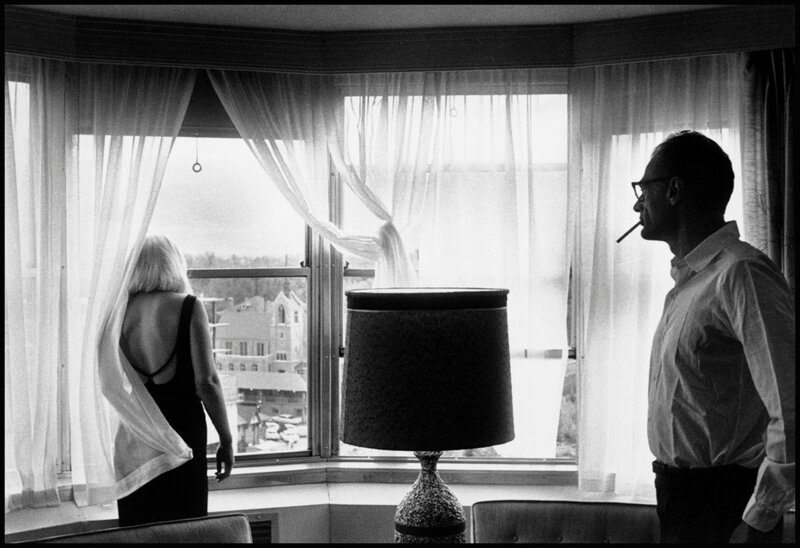
Set of "The Misfits". Marilyn Monroe and Arthur Miller in their suite in Reno’s Mapes Hotel after a day’s shooting.
Reno, Nevada. USA. 1960. © Inge Morath | Magnum Photos
John Huston’s 1961 movie, ‘The Misfits’, was to be the last completed production for two of its stars: Marilyn Monroe and Clark Gable. Gable died shortly after the film wrapped, while Monroe died in August 1962 having worked on the uncompleted movie ‘Something’s Got to Give’.
Le film de John Huston de 1961, «The Misfits», devait être la dernière production achevée pour deux de ses stars: Marilyn Monroe et Clark Gable. Gable est décédé peu de temps après la fin du film, tandis que Monroe est décédé en août 1962 après avoir travaillé sur le film inachevé «Something’s got to give».
Scripted by Arthur Miller, a raft of Magnum photographers were hired to photograph the making of the film – among them Inge Morath and Henri Cartier-Bresson, who were the first photographers to arrive on set.
Scénarisé par Arthur Miller, une série de photographes Magnum ont été embauchés pour photographier la réalisation du film - parmi lesquels Inge Morath et Henri Cartier-Bresson, qui ont été les premiers photographes à arriver sur le plateau.
As many of the images, and indeed Morath’s remembrances, attest – the photographers and the actors enjoyed a degree of camaraderie in spite of the film’s widely reported troubled production – one aspect of which was the deteriorating marriage between Miller and Monroe that came to an end that summer.
Comme de nombreuses images, et même les souvenirs de Morath, l'attestent - les photographes et les acteurs ont bénéficié d'une certaine camaraderie malgré la production troublée largement rapportée du film - dont l'un des aspects était la détérioration du mariage entre Miller et Monroe qui a pris fin cet été là.
In James Goode’s 1963 book, The Story of ‘The Misfits’ – a day-by-day account of the shoot – he hints at the friendly atmosphere the photographers and the actors shared in:
August 1 – Monday. Still no shooting call. To pass the time, Eli Wallach has gotten himself into character clothes and makeup as Sigmund Freud, to be photographed by Inge Morath. The object is to paste the resulting photograph on an album cover as a birthday present for John Huston, whose next picture will be ‘Freud’. Eli, Inge and Dick Rowan, a Magnum representative here on location, drove out to a nearby ranch and Eli posed next to a couch in the middle of a corral, with some interested horses looking on. Eli looked frighteningly authentic.
Dans le livre de James Goode de 1963, The Story of «The Misfits» - un récit quotidien du tournage - il fait allusion à l’atmosphère amicale que les photographes et les acteurs ont partagé:
1er août - lundi. Tournage toujours pas débuté. Pour passer le temps, Eli Wallach s'est habillé dans les vêtements du personnage et s'est maquillé comme Sigmund Freud, pour être photographié par Inge Morath. L’objectif est de coller la photographie obtenue sur une couverture d’album comme cadeau d’anniversaire pour John Huston, dont la prochaine photo sera «Freud». Eli, Inge et Dick Rowan, un représentant de Magnum ici sur place, se sont rendus dans un ranch voisin et Eli a posé à côté d'un canapé au milieu d'un corral, avec quelques chevaux à l'allure intéressante. Eli avait l'air terriblement authentique.
Here, ahead of the 60th anniversary of last day of the film’s shooting on location in Nevada (October 18th), we share both Miller and Morath’s personal reflections upon the film’s production and its at times troubled, yet charming stars alongside little-seen images from the production, and archival materials.
Ici, avant le 60e anniversaire du dernier jour du tournage du film dans le Nevada (le 18 octobre), nous partageons les réflexions personnelles de Miller et Morath sur la production du film et ses stars parfois troublées mais charmantes aux côtés d'images peu vues de la production et les documents d'archives.

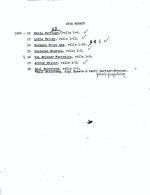
Inge Morath's story list 1960. © Inge Morath.
Inge Morath Photographs and Papers Collection,
courtesy the Beinecke Rare Book and Manuscript Library, Yale University.
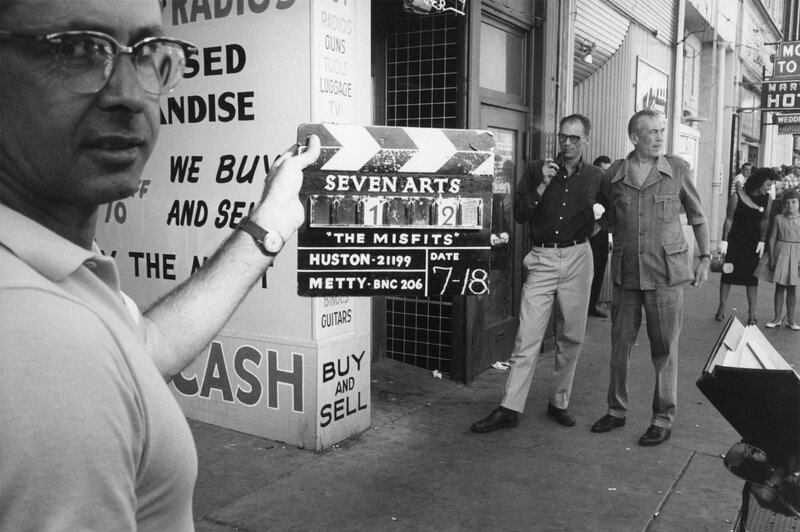
The first day of shooting "The Misfits." Clapperboard is marked scene 1 take 2.
Director John Huston and author Arthur Miller watching in the background.
Reno, Nevada. USA. 1960. © Inge Morath | Magnum Photos
Frank Taylor, who was an old friend of mine, and who I inveigled into being the producer [of ‘The Misfits’], thought it would be a great idea to get Magnum to send over as many people as they could to photograph it. I didn’t know any photographers and I had no opinion about it; it was the last thing in the world I was worried about. Henri [Cartier-Bresson] and Inge [Morath] decided to do a motor trip across the country [on their way to the set in Reno]. Both of them were Europeans, of course, and they thought that, diving across the country, they would run into all kinds of wonderful, different cooking experiences as they would in Europe. When confronted with the inevitable hamburger everywhere, they were driven back to eating carrots and apples and tea.
Frank Taylor, qui était un vieil ami à moi, et que j’ai incité à devenir le producteur [de ‘The Misfits’], a pensé que ce serait une excellente idée que Magnum envoie autant de personnes que possible pour photographier. Je ne connaissais aucun photographe et je n’avais aucune opinion à ce sujet; c'était la dernière chose au monde qui m'inquiétait. Henri [Cartier-Bresson] et Inge [Morath] ont décidé de faire un voyage en voiture à travers le pays [en route vers le plateau de Reno]. Tous deux étaient européens, bien sûr, et ils pensaient qu'en plongeant à travers le pays, ils vivraient toutes sortes d'expériences culinaires merveilleuses et différentes comme ils le feraient en Europe. Lorsqu'ils ont été confrontés à l'inévitable hamburger partout, ils ont été ramenés à manger des carottes, des pommes et du thé.
Inge wrote a diary of this trip. It’s a brilliant description of 60s America. It’s a European’s wise and, at the same time, wide-eyed view of this crazy country. She caught all the insane contradictions that were here because they were very fresh to her..."
Inge a écrit un journal de ce voyage. C'est une brillante description de l'Amérique des années 60. C'est une vision européenne sage et, en même temps, les yeux écarquillés de ce pays fou. Elle a saisi toutes les contradictions insensées qui étaient ici parce que c'était très frais pour elle ..."


Goldfield, Nevada. USA. 1960. © Inge Morath | Magnum Photos
The 60s in America, of course, was the despair and the secret hope of a lot of European intellectuals. The freedom, the local inventiveness, the friendliness, charmed them. And Inge, I know, was pleasantly surprised by how dear the people were. Of course, most people were to her; she was very affectionate toward people, and they reacted in a similar way. However, it was a difficult trip because she couldn’t eat meat and Henri liked more delicate cooking. So they were driven half mad by the carrots and the apples and the tea. And they arrived in Reno half starved and ready to work.
Les années 60 en Amérique, bien sûr, étaient le désespoir et l'espoir secret de nombreux intellectuels européens. La liberté, l'inventivité locale, la convivialité les ont charmés. Et Inge, je le sais, a été agréablement surprise de voir à quel point les gens étaient adorables. Bien sûr, la plupart des gens l'étaient pour elle; elle était très affectueuse envers les gens, et ils ont réagi de la même manière. Cependant, ce fut un voyage difficile car elle ne pouvait pas manger de viande et Henri aimait une cuisine plus délicate. Alors ils ont été rendus à moitié fous par les carottes, les pommes et le thé. Et ils sont arrivés à Reno à moitié affamés et prêts à travailler.
Inge wrote a diary of this trip. It’s a brilliant description of 60s America. It’s a European’s wise and, at the same time, wide-eyed view of this crazy country. She caught all the insane contradictions that were here because they were very fresh to her; she was unprepared for them. You’ve got to remember that World War Two was still engraved on their minds. They had witnessed, and in Inge’s case she had suffered a great deal in Nazi Germany from the effects of the war. So this fresh country was overwhelming. At the same time, she had some odd experiences here. When she arrived she had to apply for a visa and one of the questions was “Your Color.” So she put down “pink.” It never dawned on her that any government would ask what color you were, and it was quite a shock. She didn’t know what to make of it.
Inge a écrit un journal de ce voyage. C’est une brillante description de l’Amérique des années 60. C’est une vision européenne sage et, en même temps, des yeux écarquillés de ce pays fou. Elle a saisi toutes les contradictions insensées qui étaient ici parce qu'elles étaient très fraîches pour elle; elle n'était pas préparée pour ça. Vous devez vous rappeler que la Seconde Guerre mondiale était toujours gravée dans leur esprit. Ils en avaient été témoins et, dans le cas d’Inge, elle avait beaucoup souffert en Allemagne nazie des effets de la guerre. Donc, ce pays frais était écrasant. En même temps, elle a eu des expériences étranges ici. À son arrivée, elle a dû demander un visa et l'une des questions était «Votre couleur». Alors elle a mis «rose». Il ne lui est jamais venu à l'esprit qu'un gouvernement vous demanderait de quelle couleur vous étiez, et ce fut un vrai choc. Elle ne savait pas quoi en penser.


Small travel notebook. © Inge Morath.
Inge Morath Photographs and Papers Collection,
courtesy the Beinecke Rare Book and Manuscript Library, Yale University.

Set of "The Misfits". Rehearsal of Roslyn's dance in Guido's garden.
John Huston with Marilyn Monroe in the first frame.
Reno, Nevada. USA. 1960. © Inge Morath | Magnum Photos
- Arthur Miller:
"Inge took comparatively few pictures.
When she pointed the camera
she felt a certain responsibility for what it was looking at.
Her pictures of Marilyn are particularly empathetic
and touch as she caught Marilyn’s anguish beneath her celebrity..."
"Inge a pris relativement peu de photos.
Quand elle a pointé la caméra,
elle se sentait responsable face à ce qu'elle regardait.
Ses photos de Marilyn sont particulièrement empathiques
et touchantes alors qu'elle captait l'angoisse de Marilyn sous sa célébrité ..."

Set of "The Misfits". Marilyn Monroe in the first frame. Reno, Nevada. USA. 1960. © Inge Morath | Magnum Photos
Inge, as an Austrian, had found herself in a defensive position in London and Paris, where she had been working and living [after the war]. Americans, in contrast, were far less ready to condemn her. Ironically, she felt uneasy here because we didn’t condemn fascism enough, nor did we see the signs of it in American culture. She was quick to notice whenever that smell came up of repression and racism.
Inge, en tant qu'Autrichienne, s'était retrouvée dans une position défensive à Londres et à Paris, où elle avait travaillé et vécu [après la guerre]. Les Américains, en revanche, étaient beaucoup moins disposés à la condamner. Ironiquement, elle s'est sentie mal à l'aise ici parce que nous n'avons pas assez condamné le fascisme, et nous n'en avons pas vu les signes dans la culture américaine. Elle a vite remarqué chaque fois cette odeur de répression et de racisme qui se dégageait.
Reno, initially, and ‘The Misfits’ in particular, was a circus for Inge; a rich mine of subjects. My first glimpse of her was in the Mapes Hotel coffee shop, where she was sitting at a table laughing with John Huston. She had worked on Huston’s film ‘Moulin Rouge’ some time earlier, and had earned his respect as an artist. Huston’s admiration and respect came in part from the work, of course, but it was also because of her bravery. As far as he was concerned, that was the major virtue of anyone.
Reno, au départ, et «The Misfits» en particulier, était un cirque pour Inge; une mine riche de sujets. La première fois que je l'ai vue, elle était dans le café de l'hôtel Mapes, assise à une table en train de rire avec John Huston. Elle avait travaillé sur le film de Huston «Moulin Rouge» quelque temps auparavant et avait gagné son respect en tant qu’artiste. L’admiration et le respect de Huston provenaient en partie du travail, bien sûr, mais c’était aussi à cause de sa bravoure. En ce qui le concernait, c'était la principale vertu de quiconque.
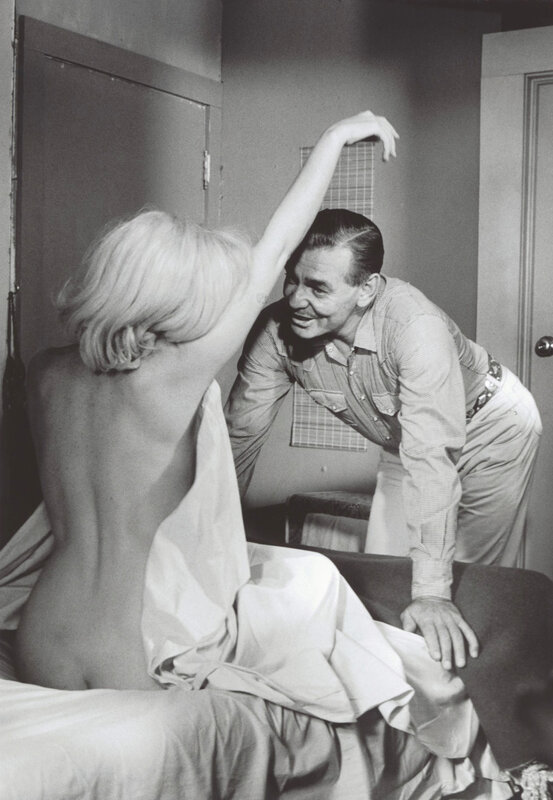
Set of "The Misfits". Clark Gable and Marilyn Monroe.
The two are now lovers and Gay, who has been up early,
comes to wake her and surprise her with breakfast.
Roslyn sits up in bed slowly, delightedly.
Movie camera cuts shot of Roslyn’s back a little under her shoulders.
Reno, Nevada. USA. 1960. © Inge Morath | Magnum Photos


1/"The Misfits." Marilyn Monroe and Arthur Miller.
2/ Set of "The Misfits". John Huston and Arthur Miller wait and brood over the next scene.
This close cooperation of author and director often brought about last minute changes
that kept the work on the movie at an exhilarating pace.
Reno, Nevada. USA. 1960. © Inge Morath | Magnum Photos

John Huston, Marilyn Monroe & Arthur Miller during the filming of "The Misfits".
Arthur & Marilyn were separated at the time.
Nevada. Reno. USA. 1960. © Inge Morath | Magnum Photos
Inge believes that to photograph a place you had to know the language. So she studied Chinese for about seven years before she went to China, and she did, similarly, with Russian before she went to Russia. Travel with her was a privilege because I would never have been able to penetrate that way. She was unobtrusive and she simply took [her subjects’] side of the lens. People quickly caught on that she was a different kind of a person than they were expecting in a photographer. She had a great talent for drawing people in, even without the camera.
Inge pense que pour photographier un endroit, il fallait en connaître la langue. Elle a donc étudié le chinois pendant environ sept ans avant de se rendre en Chine, et elle a fait de même avec le russe avant de se rendre en Russie. Voyager avec elle était un privilège car je n'aurais jamais pu m'immerger de cette façon. Elle était discrète et elle a simplement pris le côté [de ses sujets] de l'objectif. Les gens ont vite compris qu'elle était une personne différente de celle à laquelle ils s'attendaient chez un photographe. Elle avait un grand talent pour attirer les gens, même sans caméra.
© Arthur Miller Literary and Dramatic Property Trust. Text excerpted from a discussion of Inge Morath’s photographs at the Howard Greenberg Gallery, New York, May 26, 2004.
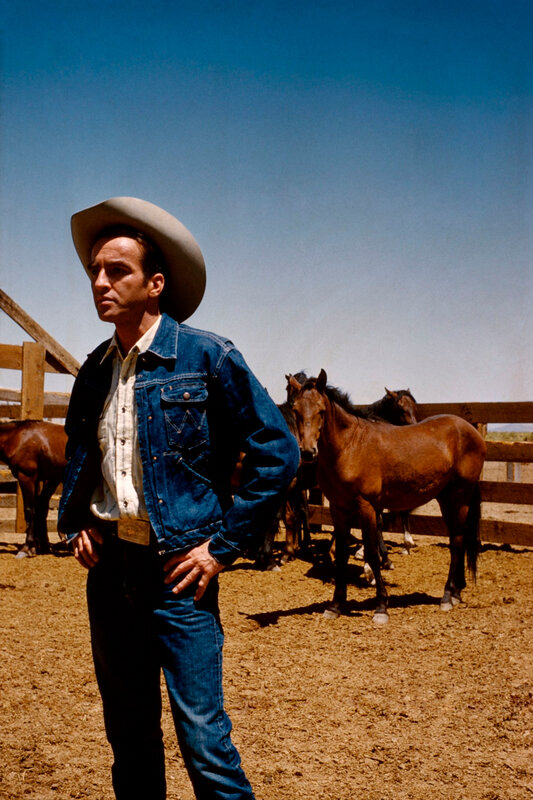
Montgomery Clift on the set of "The Misfits." Reno, Nevada. USA. 1960.
© Inge Morath | Magnum Photos
Inge Morath
The coverage of ‘The Misfits’ was a very special thing. The producer had a unique idea of creating a document of the shooting of this movie, for which he hired Magnum photographers. We were paired up and I was going to photograph with Henri Cartier-Bresson. We planned to go across the country because America was a big adventure. I didn’t know much about America at all, so we rented a car and went a very complicated route; Blue Ridge Mountains and Mississippi and we saw all the literary sights.
Le reportage de "The Misfits" était une chose très spéciale. Le producteur a eu une idée unique de créer un document du tournage de ce film, pour lequel il a engagé des photographes Magnum. Nous étions jumelés et j'allais photographier avec Henri Cartier-Bresson. Nous avions prévu de parcourir le pays car l'Amérique était une grande aventure. Je ne savais pas grand-chose du tout de l'Amérique, alors nous avons loué une voiture et avons emprunté un chemin très compliqué; Blue Ridge Mountains et Mississippi et nous avons vu tous les sites littéraires.
Anyway we arrived in Reno, which is American and so western. It’s just marvelous to look at. The Mapes Hotel was where more or less everybody was lodged, and I was so intrigued because in the hotel room there was a machine and you could make your own coffee in the morning. I’d never seen such a thing. This was exotic. And naturally, such an American movie was also exotic to us. So we approached it from our very European point of view, which was fun. We started early, often waited for very long times, and finished quite late. And it got hotter and hotter.
Bref, nous sommes arrivés à Reno, qui est américaine et tellement western. C’est tout simplement merveilleux à regarder. L'hôtel Mapes était l'endroit où plus ou moins tout le monde était logé, et j'étais tellement intrigué parce que dans la chambre d'hôtel il y avait une machine et vous pouviez faire votre propre café le matin. Je n’avais jamais vu une chose pareille. C'était exotique. Et naturellement, un tel film américain était aussi exotique pour nous. Nous l'avons donc abordé de notre point de vue très européen, ce qui était amusant. Nous avons commencé tôt, avons souvent attendu très longtemps et avons terminé assez tard. Et il faisait de plus en plus chaud.
Henri and I had worked together before, so we were never in each other’s way. Because two photographers on one movie could be really falling over each other. But we had very different territories and interests, at least in the approach to something. I think everybody has a certain distance at which he or she is most comfortable. There is a certain way of seeing the same thing in a different composition, or from a very different angle. That’s the interesting part; everybody has their own was of attacking a subject. I’m one who always wanders around a lot, always looking. And so doe Henri, but boy is he fast. Wow.
Henri et moi avions déjà travaillé ensemble, donc nous ne nous sommes jamais opposés. Parce que deux photographes sur un même film pourraient vraiment tomber l'un sur l'autre. Mais nous avions des territoires et des intérêts très différents, du moins dans l'approche de quelque chose. Je pense que chacun a une certaine distance à laquelle il ou elle est le plus à l'aise. Il y a une certaine manière de voir la même chose dans une composition différente, ou sous un angle très différent. C’est la partie intéressante; chacun a sa manière propre d'attaquer un sujet. Je suis celle qui erre toujours beaucoup, toujours à la recherche. Et Henri aussi, mais garçon est rapide. Sensationnel.

Henri Cartier-Bresson with actor Eli Wallach (right) during the production of "The Misfits."
Reno, Nevada. USA. 1960. © Inge Morath | Magnum Photos
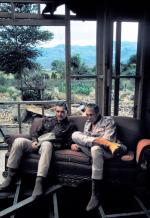
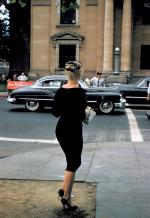
1/ Clark Gable and John Huston during the filming of The Misfits.
2/ Marilyn Monroe during the filming of The Misfits. USA. Reno, Nevada. 1960.
© Inge Morath | Magnum Photos
- Inge Morath:
"Eli and Marilyn were like buddies, and you can see it.
Monty and Marilyn were kindred souls.
They were both terribly vulnerable.
And Clark Gable was Clark Gable"
«Eli et Marilyn étaient comme des copains, et vous pouvez le voir.
Monty et Marilyn étaient des âmes apparentées.
Ils étaient tous les deux terriblement vulnérables.
Et Clark Gable était Clark Gable»
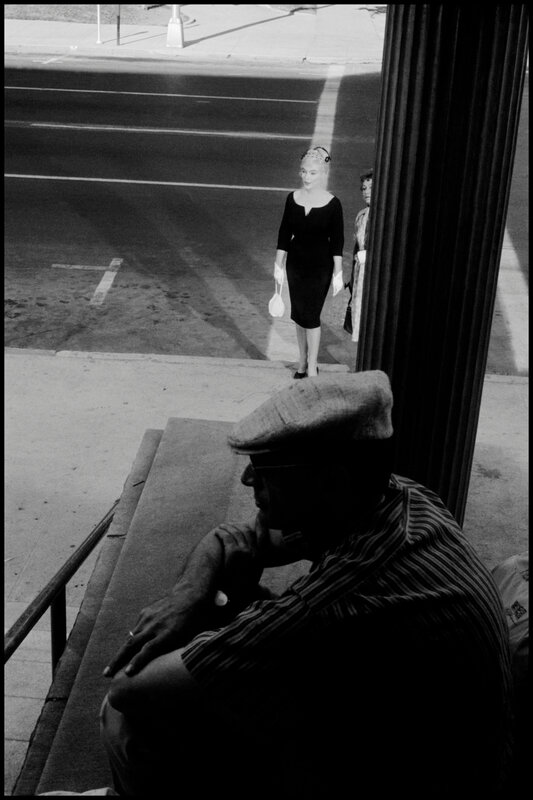
Arthur Miller (foreground) and Marilyn Monroe during the filming of "The Misfits."
Reno, Nevada. USA. 1960. © Inge Morath | Magnum Photos
John Huston I’d worked with before. He was terrific to me. My very first movie job was with him in ‘Moulin Rouge.’ I had never been in a film studio, and I went up to him and I said, “Look, I’ve never been in a film studio so you’d better help me.” He thought that was very funny. So I worked with him several times later. Monty Clift was also a great friend of mine whom I adored. He was supposed to be so difficult and erratic but actually he shot the most difficult scene in one take. Thelma Ritter was marvelous because it was a part which was not very glamourous, but she anchored this very American thing. And Eli Wallach. Eli is a funny guy and a wonderful actor. Eli and Marilyn were like buddies, and you can see it. Monty and Marilyn were kindred souls. They were both terribly vulnerable. And Clark Gable was Clark Gable.
John Huston, j'avais déjà travaillé avec lui avant. Il a été formidable avec moi. Mon tout premier boulot au cinéma était avec lui au 'Moulin Rouge.' Je n'avais jamais été dans un studio de cinéma, et je suis allée vers lui et j'ai dit: “Écoutez, je n'ai jamais été dans un studio de cinéma alors vous feriez mieux de m'aider." Il a trouvé que c'était très drôle. J'ai donc travaillé avec lui plusieurs fois plus tard. Monty Clift était aussi un grand ami à moi que j'adorais. Il était censé être si difficile et erratique, mais en fait, il a tourné la scène la plus difficile en une seule prise. Thelma Ritter était merveilleuse car c'était un rôle qui n'était pas très glamour, mais elle a ancré ce truc très américain. Et Eli Wallach. Eli est un gars drôle et un acteur merveilleux. Eli et Marilyn étaient comme des copains, et vous pouvez le voir. Monty et Marilyn étaient des âmes apparentées. Ils étaient tous les deux terriblement vulnérables. Et Clark Gable était Clark Gable.
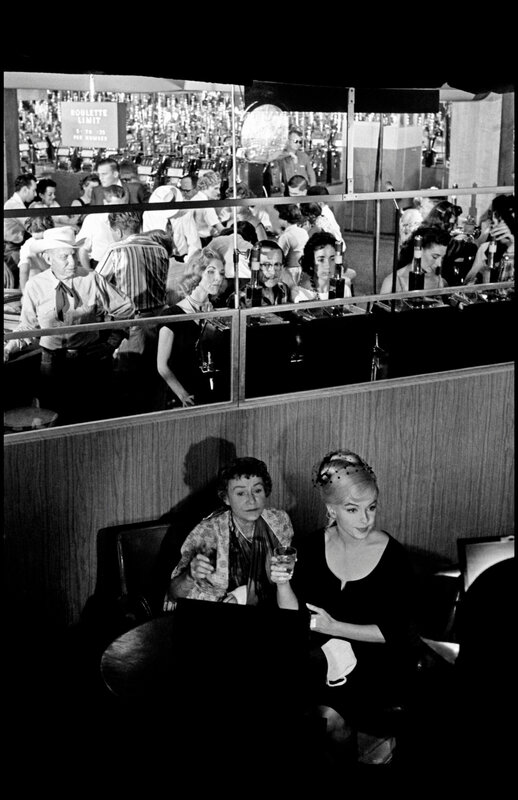
Set of "The Misfits". Marilyn Monroe and Thelma Ritter during the scene in the bar of Harrah’s Club in Reno.
Reno, Nevada. USA. 1960. © Inge Morath | Magnum Photos
- Inge Morath
"They were all very interesting to watch.
Actually, Marilyn was fascinating to watch.
The way she moved, her expressions; she just was extraordinary.
There was such strength and energy combined with this fragility"
"Ils étaient tous très intéressants à regarder.
En fait, Marilyn était fascinante à regarder.
La façon dont elle bougeait, ses expressions; elle était juste extraordinaire.
Il y avait une telle force et énergie combinées à cette fragilité"


1/ Marilyn Monroe in a casino during the production of "The Misfits."
2/ The Misfits." Clark Gable.
Reno, Nevada. USA. 1960. © Inge Morath | Magnum Photos
But it was very professional. You see, these were not people who were start stuck of anything. I mean, you were just there and you did a job; you watched as photographers have to do. They were all very interesting to watch. Actually, Marilyn was fascinating to watch. The way she moved, her expressions; she just was extraordinary. There was such strength and energy combined with this fragility. It was vert interesting and quite unique. What I wanted to do was the unposed person. Marilyn knew all the tricks about how to pose, but when I watched her and saw that vulnerability, I figured to get something of her that is not posed, some inner side of her that can be revealed if possible with the camera. You might see in some of the close-ups, behind the smile there is a tragic undertone.
Mais c'était très professionnel. Vous voyez, ce n'étaient pas des gens qui étaient coincés dans quoi que ce soit. Je veux dire, vous étiez juste là et vous avez fait un travail; vous avez regardé comme les photographes doivent faire. Ils étaient tous très intéressants à regarder. En fait, Marilyn était fascinante à regarder. La façon dont elle bougeait, ses expressions; elle était juste extraordinaire. Il y avait une telle force et énergie combinées à cette fragilité. C'était très intéressant et assez unique. Ce que je voulais faire, c'était la personne sans pose. Marilyn connaissait toutes les astuces pour poser, mais quand je l'ai regardée et que j'ai vu cette vulnérabilité, j'ai pensé obtenir quelque chose d'elle qui n'est pas posé, un côté intérieur d'elle qui peut être révélé si possible avec la caméra. Vous pourriez voir dans certains des gros plans, derrière le sourire, il y a une nuance tragique.
The thing is that she was very unsecure about herself. Marilyn was nervous about many scenes and she would really try to have different takes on things. She went back to the script and sometimes that took up a considerable amount of time. So people were sitting in the heat, and it was very hot. I remember Clark Gable, with whom I got on very well, told me all his adventures in the movies. It was very funny. Clark was wonderful. He said, “I will inscribe your jacket for you,” you know, I never had the idea of asking for an autograph. So he wrote on the back of my collar, “Clark Gable, Reno, Nevada, July 21st, 1960.” And he said, “You’d better have somebody embroider this so it won’t wash out.” So I had it made in Paris, embroidered on the back of the collar.
Le fait est qu'elle n'était pas sûre d'elle-même. Marilyn était nerveuse à propos de nombreuses scènes et elle aurait essayé vraiment d'avoir des points de vue différents sur les choses. Elle revenait sur le scénario et parfois cela prenait un temps considérable. Les gens étaient donc assis dans la chaleur, et il faisait très chaud. Je me souviens que Clark Gable, avec qui je m'entendais très bien, m'a raconté toutes ses aventures au cinéma. C'était très drôle. Clark était merveilleux. Il a dit: «Je vais signer votre veste pour vous», vous savez, je n'ai jamais eu l'idée de demander un autographe. Il a donc écrit au dos de mon col: «Clark Gable, Reno, Nevada, 21 juillet 1960». Et il a dit: "Tu ferais mieux de faire broder ça par quelqu'un pour qu'il ne s'efface pas." Je l'ai donc fait fabriquer à Paris, brodée à l'arrière du col.
We wanted to be as invisible as possible as photographers. You have to be pretty much invisible because you are in the way most of the time. so we always were dressed in all drab stuff. And I think there’s something to it, to serving your subject by not putting yourself close too much. The thing was to find your way around. You knew more or less what scenes would come up but you didn’t know what was actually going to happen. The surprise elements were in how the actors created a scene, and John Huston kind of let them find their way. I mean, there was a general direction, but within this they found their own way.
Nous voulions être aussi invisibles que possible en tant que photographes. Vous devez être à peu près invisible parce que vous êtes gênant la plupart du temps. Donc nous étions toujours vêtus de couleur terne. Et je pense qu'il y a quelque chose à faire, à servir votre sujet en ne vous mettant pas trop près. Le truc était de trouver son chemin. Vous saviez plus ou moins quelles scènes allaient se produire mais vous ne saviez pas ce qui allait réellement se passer. Les éléments de surprise étaient dans la façon dont les acteurs ont créé une scène, et John Huston les a en quelque sorte laissés trouver leur chemin. Je veux dire, il y avait une direction générale, mais à l'intérieur de cela, ils ont trouvé leur propre chemin.
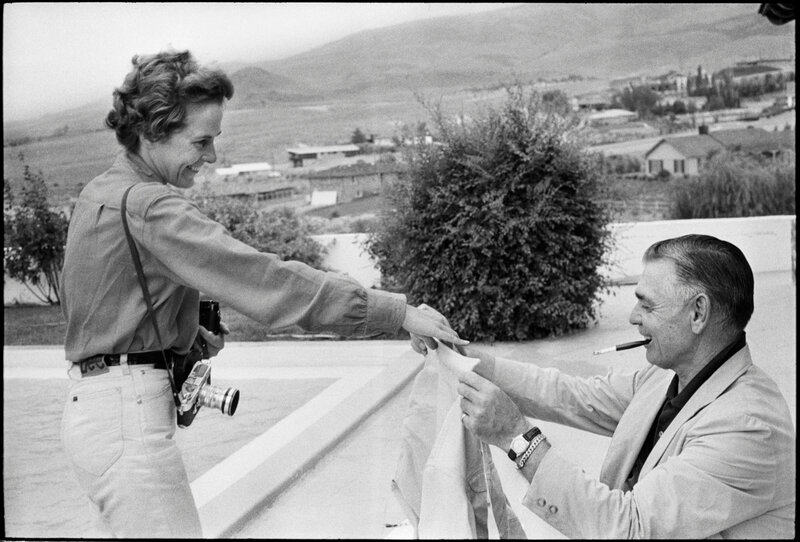
Shooting "The Misfits". 1960. The photographer Inge Morath and Clark Gable.
Nevada state. USA. © Henri Cartier-Bresson | Magnum Photos


1/ Marilyn Monroe and Eli Wallach. Reno, Nevada. USA. 1960
2/ Set of "The Misfits". Clark Gable and Marilyn Monroe. Reno, Nevada. USA. 1960.
© Inge Morath | Magnum Photos
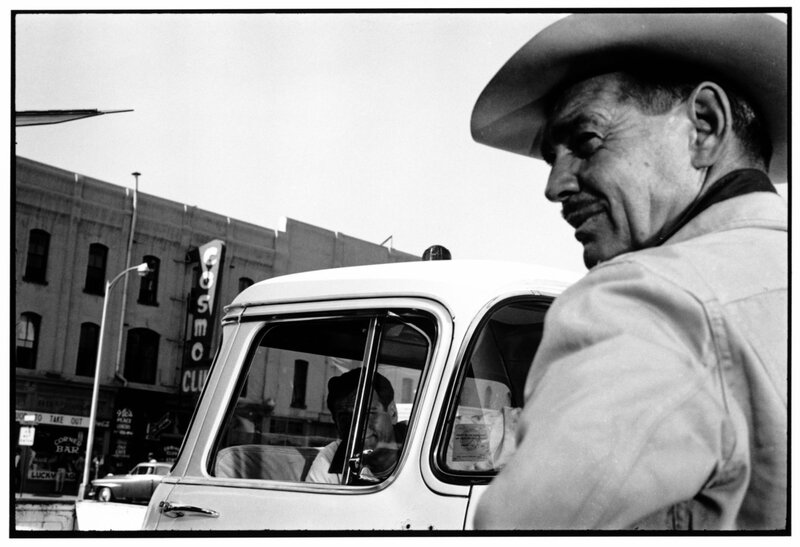
"The Misfits." Clark Gable and Eli Wallach in the car. Reno, Nevada. USA. 1960.
© Inge Morath | Magnum Photos
I had read the short story and I get a script. If you’re not used to reading movie scripts its quite something, because you don’t imagine everything. So it’s kind of a dry enterprise. But we knew more or less what the character were, which is really what you want to know; what makes these people tick ? I mean, what the author meant making tick. Naturally, I was kind of in awe of Arthur Miller because I’d seen ‘Salesman’ and ‘The Crucible’ and I though, oh God, this man will be very sad all the time. the first time I really met him, it was very hot. John Huston took Henri and me to where they were swimming and playing tennis. We didn’t go in the pool because we were busy photographing.
J'avais lu la nouvelle et je reçois un scénario. Si vous n’avez pas l’habitude de lire des scripts de films, c’est quelque chose, car vous n’imaginez pas tout. C’est donc une sorte d’entreprise sèche. Mais nous savions plus ou moins ce qu'était le personnage, ce que vous voulez vraiment savoir; qu'est-ce qui motive ces gens ? Je veux dire, ce que l'auteur voulait dire faisant tique. Naturellement, j'étais un peu impressionnée par Arthur Miller parce que j'avais vu "Salesman" et "The Crucible" et je pensais, oh mon Dieu, que cet homme serait très triste tout le temps. La première fois que je l'ai vraiment rencontré, il faisait très chaud. John Huston a emmené Henri et moi là où ils nageaient et jouaient au tennis. Nous ne sommes pas allés dans la piscine car nous étions occupés à photographier.
Arthur was swimming a backstroke, and he told a very funny story, swimming all the time. It was a short story which he wrote about a guy who was making shoulder pads. I never heard of anyone making shoulder pads; that was in itself exotic. But it was a very funny story, and very long. And then he finished the story and got out of the water, and I got a whole new idea about Arthur Miller being a funny fellow.
Arthur nageait sur le dos et il a raconté une histoire très drôle, nageant tout le temps. C'était une histoire courte qu'il a écrite sur un gars qui fabriquait des épaulettes. Je n'ai jamais entendu parler de quelqu'un qui fabriquait des épaulettes; c'était en soi exotique. Mais c'était une histoire très drôle et très longue. Et puis il a terminé l'histoire et est sorti de l'eau, et j'ai eu une toute nouvelle idée du fait qu'Arthur Miller était un garçon marrant.
[© Inge Morath. Text compiled from a conversation with Inge Morath by Gail Levin for the film ‘Making the Misfits’, Great Performances, Thirteen/WNET, 2001.]
Both Arthur Miller’s and Inge Morath’s texts appear in Inge Morath’s The Road to Reno, edited by John P. Jacob. Steidl: Germany, 2006.

Set of "The Misfits". Marilyn Monroe. Reno, Nevada. USA. 1960. © Inge Morath | Magnum Photos
© All images are copyright and protected by their respective owners, assignees or others.
copyright text by Magnum.

Magnum on Set: The Misfits
| en ligne sur magnumphotos.com
Eve Arnold captured the troubled final cinematic outing for both Marilyn Monroe and co-star Clark Gable
Eve Arnold a capturé le dernier film troublant de Marilyn Monroe et de sa co-vedette Clark Gable
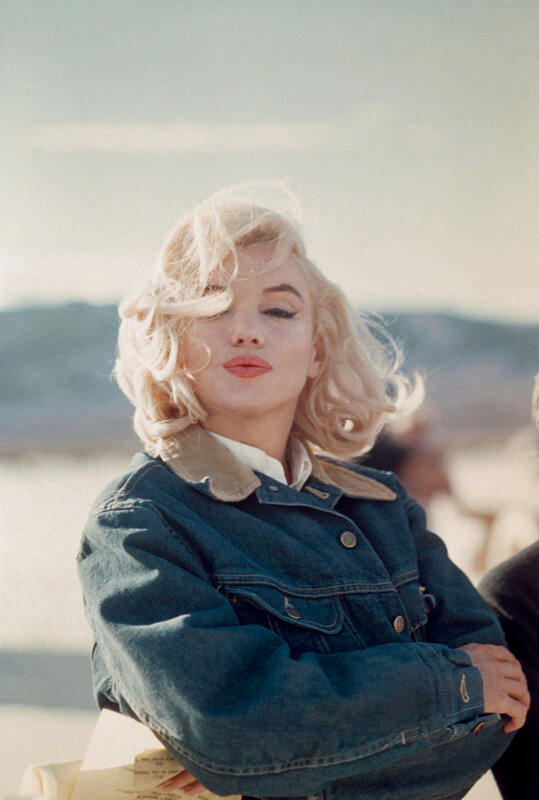
US actress Marilyn Monroe on the Nevada desert during the filming of "The Misfits",
directed by John Huston. USA. 1960. © Eve Arnold | Magnum Photos
(...) Look at Eve Arnold’s coverage of the making of The Misfits, a film that failed at the box office, in spite of its deeply troubled all-star cast – two of whom would never make another film.
Regarder le reportage d'Eve Arnold sur la réalisation de The Misfits, un film qui a échoué au box-office, en dépit de son casting de stars profondément troublées - dont deux d'entre elles ne feront jamais un autre film.
Eve Arnold didn’t know it at the time, but what she photographed on the set of 1961’s The Misfits was to be the last movie completed by Marilyn Monroe and her co-star Clark Gable. The film, an elegiac tale of divorce and aging cowboys, is tainted with sadness as Monroe’s swansong. She died of an overdose just a year after the film’s release.
Eve Arnold ne le savait pas à l'époque, mais ce qu'elle a photographié sur le tournage de The Misfits en 1961 devait être le dernier film réalisé par Marilyn Monroe et sa co-star Clark Gable. Le film, un conte élégiaque de divorce et de cow-boys vieillissants, est teinté de tristesse comme le chant du cygne de Monroe. Elle est décédée d’une overdose juste un an après la sortie du film.
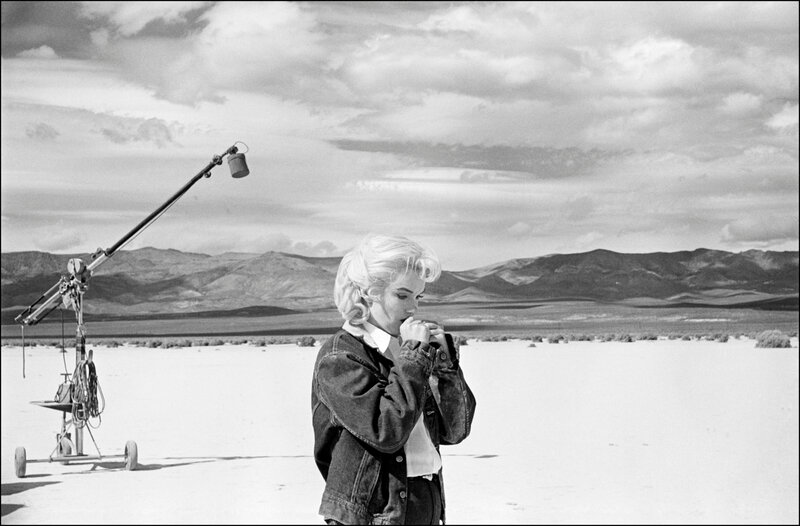
US actress Marilyn Monroe on the Nevada desert going over her lines for a difficult scene
she is about to play with Clark Gable in the film "The Misfits" by John Huston.
Nevada. USA. 1960. © Eve Arnold | Magnum Photos


USA. Nevada. Reno.
US actress Marilyn MONROE on the set of 'The Misfits' by John HUSTON. 1960.
© Eve Arnold | Magnum Photos
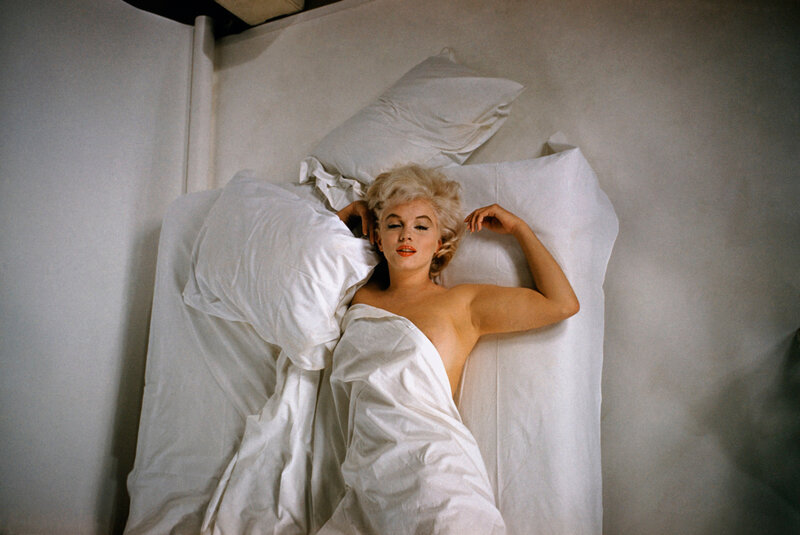
US actress Marilyn Monroe. Los Angeles. California. USA. 1960.
© Eve Arnold | Magnum Photos
By all accounts, The Misfits was a troubled production. Directed by John Huston from a script by Arthur Miller, it was shot in the blistering 107-degree heat of the Nevada desert. There was the breakdown of Monroe and Miller’s marriage to contend with. There was Huston’s drinking and gambling. There was Monroe’s descent into alcohol and prescription drug use, not to mention the fact she rarely showed up on time, if at all. Huston, in a Rolling Stone interview, later said he was “absolutely certain that she was doomed” during the production. Filming even halted for two weeks while she was hospitalized, reportedly for detox.
Au dire de tous, The Misfits était une production en difficulté. Réalisé par John Huston à partir d'un scénario d'Arthur Miller, il a été tourné dans la chaleur fulgurante de 40 degrés dans le désert du Nevada. Il y avait la rupture du mariage de Monroe et Miller à affronter. Il y avait la boisson et le jeu de Huston. Il y a eu la descente de Monroe dans la consommation d'alcool et de médicaments sur ordonnance, sans parler du fait qu'elle se présentait rarement à l'heure, voire pas du tout. Huston, dans une interview à Rolling Stone, a déclaré plus tard qu'il était «absolument certain qu'elle était condamnée» pendant la production. Le tournage s'est même arrêté pendant deux semaines alors qu'elle était hospitalisée, apparemment pour une cure de désintoxication.
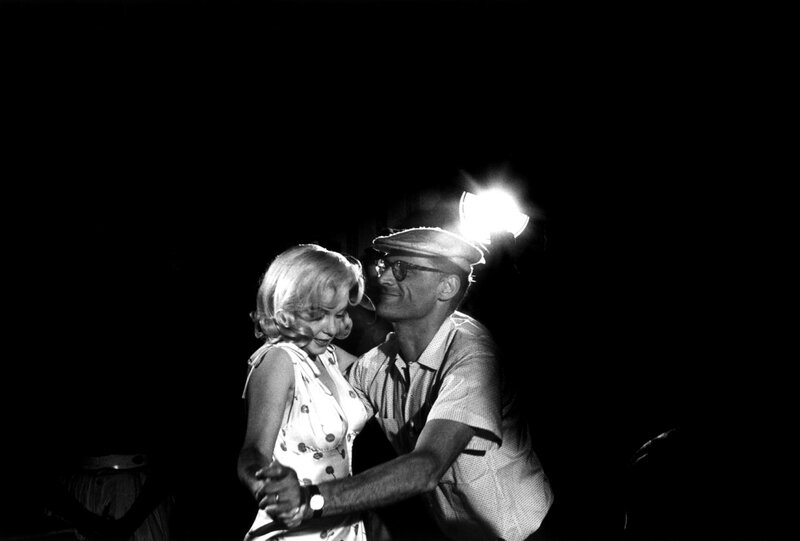
US actress Marilyn Monroe with Arthur Miller showing her some dance steps for a scene she has to play.
Miller was describing the way his father used to "Skip-to-my-lou", a rustic dance from middle America.
Reno. Nevada. USA. 1960. © Eve Arnold | Magnum Photos
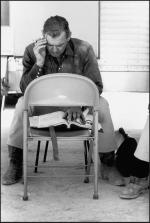
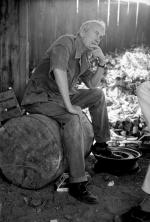
1/ Clarke Cable learing his lines during the the filming of the The Misfits.
2/ John Huston, the director during the filming of The Misfits.
Reno. Nevada. USA. 1960. © Eve Arnold | Magnum Photos
In her photographs, Arnold captures Monroe and Miller sitting on the back of a truck, her staring pensively at the ground. In another, Miller is showing her some dance moves for a scene. The photographer captures Gable – who died 12 days after production wrapped – with his wife, dressed formally and standing under an orange tree. Arnold followed the production from Reno to Dayton, from the Nevada desert to LA. Sometimes she was a fly on the wall, revealing an unseen side of these cultural icons. Other times she asked them to pose for her camera in-between takes.
Dans ses photographies, Arnold capture Monroe et Miller assis à l'arrière d'un camion, fixant pensivement le sol. Dans un autre, Miller lui montre quelques mouvements de danse pour une scène. La photographe capture Gable - décédé 12 jours après la fin de la production - avec sa femme, habillée formellement et debout sous un oranger. Arnold a suivi la production de Reno à Dayton, du désert du Nevada à Los Angeles. Parfois, elle était comme une mouche sur un mur, révélant un côté invisible de ces icônes culturelles. D'autres fois, elle leur a demandé de poser pour sa caméra entre les prises.

Clarke Gable and his wife Encino. California. USA. 1960.
© Eve Arnold | Magnum Photos

US actress Marilyn Monroe rest between takes under the surveillance of Paula Strasberg,
Monroe's drama coach, on the set of the 'The Misfits' by John Huston.
Nevada. USA. 1960. © Eve Arnold | Magnum Photos
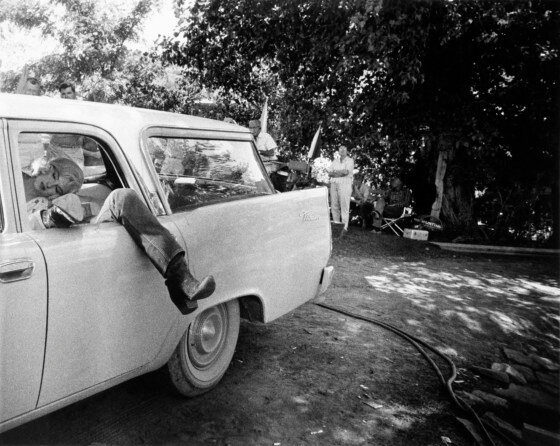
Marilyn Monroe on the set of the Misfits sleep during a lunchbreak.
Nevada. USA. 1960 © Eve Arnold | Magnum Photos
Though it was both Monroe and Gable’s final film, it tanked at the box office. Only in recent decades has it garnered acclaim as a moody, monochrome story of loneliness in the West, with the Guardian dubbing it a “melancholy drama that pulses with sadness and symbolism”. Like the mournful tone of the film, Arnold’s pictures carry an unintended emotional weight, the story behind the production – Monroe’s tortured soul – as intriguing and stirring as the film itself.
Bien qu’il s’agisse à la fois du dernier film de Monroe et de Gable, il a fait un flop au box-office. Ce n'est qu'au cours des dernières décennies qu'il a été acclamé comme une histoire sombre et monochrome de solitude en Occident, avec le Guardian le surnommant un «drame mélancolique qui vibre de tristesse et de symbolisme». Comme le ton triste du film, les images d'Arnold ont un poids émotionnel involontaire, l'histoire derrière la production - l'âme torturée de Monroe - aussi intrigante et émouvante que le film lui-même.
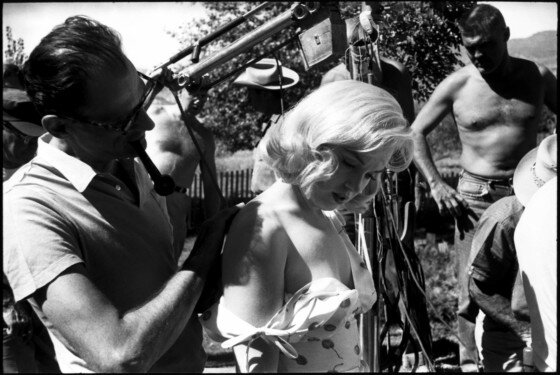
Marilyn Monroe being given a neck massage by Arthur Miller,
to help relieve tension during location filming.
Nevada. USA. 1960. © Eve Arnold | Magnum Photos
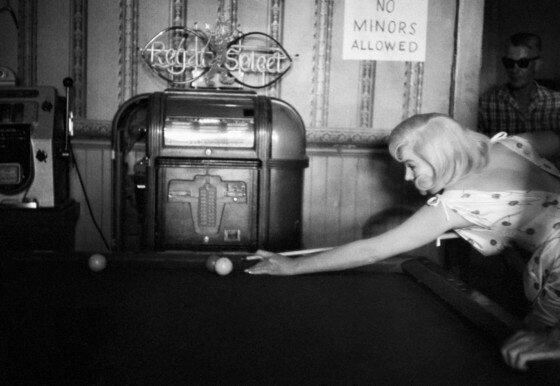
Marilyn Monroe during the filming of The Misfits. Reno. Nevada. USA. 1960.
© Eve Arnold | Magnum Photos

Marilyn Monroe during the filming of 'The Misfits'. USA. 1960.
© Eve Arnold for AP © Eve Arnold
© All images are copyright and protected by their respective owners, assignees or others.
copyright text by Magnum.
Aviones en mitad del siglo XX, Marilyn Monroe y el barrigazo del Deportes Tolima
23/08/2020 | en ligne sur tolimaonline.com
traduction de l'article
Article de German Nino
Il y a quelques jours, mon amie Diana Ucrós, enseignante et bonne photographe, a publié une photo sur son mur Facebook qui a retenu mon attention, car je ne savais pas ou je l'avais vue publiée sur Internet. C'est une photo de la belle actrice Marilyn Monroe, posant devant un avion Avianca, que je partagerai avec vous.

- Marilyn Monroe -
Photo originale appartenant à la famille de Diana Ucrós
Avec les données publiées par Diana, je me suis mis à enquêter sur l'histoire de la photo, ce qui est très intéressant. La photo a été prise le jeudi 3 janvier 1957 sur la piste de l'aéroport de Montego Bay, en Jamaïque. L'actrice avait voyagé de New York à Montego Bay sur le vol Avianca 670, dont la totalité du trajet était New York - Montego Bay - Barranquilla - Bogotá. Précisant que je suis économiste et que je ne connais pas grand chose aux avions, il s'agissait d'un Lockheed L-1049E Super Constellation, qu'Avianca utilisait sur ses vols vers les États-Unis et la Jamaïque.
Marilyn voyageait en compagnie de son mari, l'écrivain et dramaturge Arthur Miller, et d'un autre couple, le cousin d'Arthur et sa femme. Marilyn et Arthur s'étaient mariés en juin 1956, mais leur travail les avait empêchés de partir en lune de miel. Marilyn avait tourné un film avec l'acteur Laurence Olivier, "Le Prince et la Danseuse" dans la seconde moitié de 1956, tandis que Miller travaillait sur une nouvelle pièce. Le temps glacial de New York début janvier les a décider de s'envoler soudainement pour la Jamaïque, trouvant que la meilleure alternative était le vol d'une petite compagnie aérienne colombienne, qui ouvrait la route vers la Jamaïque depuis 1956, avec ces avions Super Constellation. .
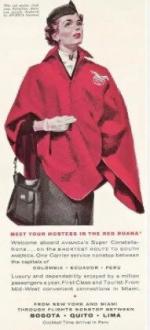 Quelques mois avant le vol des Miller vers la Jamaïque, Avianca était entré dans l'histoire avec un autre de leurs avions. Le 18 novembre 1956, un Douglas DC-4, le HK-136, a quitté l'aéroport de Techo à Bogotá avec la délégation colombienne pour les Jeux Olympiques de Melbourne, lors d'un voyage parrainé par Avianca. C'était la quatrième participation de la Colombie aux J.O. et 32 athlètes étaient dans l'avion. Le voyage a duré 61 heures et l'itinéraire était Bogotá - Barranquilla - Brownsville (USA) - San Francisco - Honolulu, Hawaï - Canton (Chine) - Fidji - Melbourne. L'avion dans lequel ce vol a été effectué se trouve dans le parc Jaime Duque (qui apparaît dans cette chronique), au nord de Bogotá. Marilyn et Arthur ont dû en entendre parler pour décider de voyager avec Avianca, où leurs hôtesses se sont également démarquées, qui lançait au cours de cette décennie l'uniforme rouge, si caractéristique de la compagnie aérienne nationale colombienne.
Quelques mois avant le vol des Miller vers la Jamaïque, Avianca était entré dans l'histoire avec un autre de leurs avions. Le 18 novembre 1956, un Douglas DC-4, le HK-136, a quitté l'aéroport de Techo à Bogotá avec la délégation colombienne pour les Jeux Olympiques de Melbourne, lors d'un voyage parrainé par Avianca. C'était la quatrième participation de la Colombie aux J.O. et 32 athlètes étaient dans l'avion. Le voyage a duré 61 heures et l'itinéraire était Bogotá - Barranquilla - Brownsville (USA) - San Francisco - Honolulu, Hawaï - Canton (Chine) - Fidji - Melbourne. L'avion dans lequel ce vol a été effectué se trouve dans le parc Jaime Duque (qui apparaît dans cette chronique), au nord de Bogotá. Marilyn et Arthur ont dû en entendre parler pour décider de voyager avec Avianca, où leurs hôtesses se sont également démarquées, qui lançait au cours de cette décennie l'uniforme rouge, si caractéristique de la compagnie aérienne nationale colombienne.
Ces avions Super Constellation, surnommés Connie aux États-Unis, étaient mieux connus en Colombie sous le nom de «Super Costalazo», en raison de leurs fréquents accidents et retards dus à des pannes techniques. Heureusement, dans le cas de Marilyn Monroe, il n'y a eu aucun problème et les époux sont arrivés à Montego Bay sans incident, posant devant l'avion.
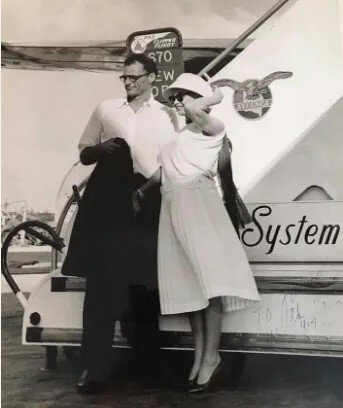
- Arthur Miller et Marilyn Monroe -
Photos originales appartenant à la famille de Diana Ucrós 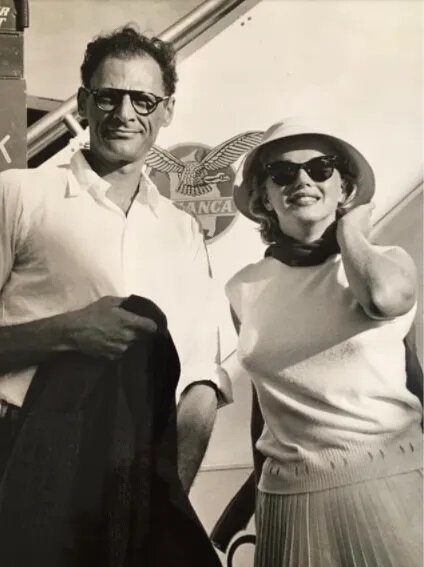
Les époux Miller ont passé une bonne lune de miel au Jamaica Inn, qui annonce toujours en slogan publicitaire la «lune de miel à la Marilyn Monroe». Il y a plusieurs photos du couple cette semaine-là. Je partage l'un des plus beaux.
CONTEXTE HISTORIQUE
Les 3 photographies de Marilyn Monroe en janvier 1957 à côté de l'avion Super Constellation d'Avianca n'avaient jamais été diffusées publiquement. Elles appartenaient à M. Juan Ucrós Pardo, cadre d'Avianca, qui les a gardés jusqu'à sa mort. Aujourd'hui, elles appartiennent à sa fille Diana Ucrós, une amie avec qui nous partageons divers intérêts, dont la photographie. Merci à Diana de m'avoir permis d'utiliser ses photos dans cette histoire.
German Nino.
© All images are copyright and protected by their respective owners, assignees or others.

My Week (and a bit) With Marilyn
April 11, 2019 - By Colin Clark - sur The Oldie
In 1956 Laurence Olivier and Marilyn Monroe were both incredibly famous. When it was announced that they were going to make a film together, it caused amazement and concern of a sort that is hard to imagine today. After all Miss Monroe was the epitome of the busty-but-brainless Hollywood blonde and Sir Laurence was the greatest classical actor of his generation etc, etc. It was really unthinkable that I should just walk into the offices of Laurence Olivier Productions, at the age of twenty-three, and demand a job. But that is what I did and, in the end, I got one.
My father, Kenneth Clark, was quite well known in intellectual circles then, and he and my mother were friends of ‘Larry & Vivien’. Even so I must have been pretty brash – what my elder brother, Alan, still calls ‘youthfully foolish’ when I do something particularly stupid. It worked out well, though. The film was an incredible adventure despite the battles between the two so different cultures.
It was really a struggle between the old and the new. Despite his work in Hollywood, Olivier always thought of a film as a photographed play. And Marilyn, who had actually appeared in as many films as Olivier had at that time (25), was totally unaware of theatrical conventions, like learning lines in advance, and coming in on cue. The crew of the film, hand-picked by Olivier, thought of anything from America as vulgar and upstart (this was the Fifties, don’t forget) and the idea of treating the movies as a brand-new medium was very threatening. I started by getting on very well with Marilyn and the whole American team. But I was always firmly in the Olivier camp, and just as well, for I was to remain as his personal assistant in the theatre for the next two years. I see now that it was Marilyn who was the ‘film star’, Marilyn, erratic as she was, who was the future.
Monday 16th July 1956
Problems – too much fakery: peroxide hair, dead white makeup, heavy lipstick, but that is her image. She looks confused too, lost, troubled. That’s the MM [Marilyn Monroe] image too, I know, but even when she’s shut the door on the reporters, she still looks in distress, not just acting it.
She doesn’t seem to be able to shrug off the image in private, to throw off her coat, slump down on the sofa and say: ‘Phew, let’s have a drink.’
She gazes at AM [Arthur Miller] as if he is a superhero, but I don’t think he is that nice. He’s clearly very handsome and very attractive, but good-hearted, no. And she hasn’t really got anyone else to depend on. A girl like that really needs her mum, but I’m told her mum is in a bin. Milton [Greene, executive producer] is clearly dependent on her, rushing round like all the others trying not to upset her, frightened of her even.
SLO [Sir Laurence Olivier] is much too remote. He’s going to be her director and that should be a close relationship, but he is quite clearly not in any way concerned with her personally. He is the supreme professional, expecting and assuming that everyone else will be professional too...
I wish SLO could be cosy with MM. He’s strong and romantic with most women but he only gets ‘cosy’ with men.
Wednesday 18th July
It goes without saying that she was late – but not very late, only half an hour... When MM did arrive we all got a shock – except Whitey [Allan Snyder, MM’s personal makeup man], I suppose. She looked absolutely frightful. No makeup, just a skirt, a tight blouse, head scarf and dark glasses. Nasty complexion, a lot of facial hair, shapeless figure and, when the glasses came off, a very vague look in her eye. No wonder she is so insecure.
She bolted into her dressing-room with Milton and Whitey and stayed there for twenty minutes. Eventually they coaxed her out, looking very tense indeed, and walked her to the small studio. The whole idea is to film her first without makeup on, so she sat on a stool, under the bright lights, like a prisoner of war...
Thursday 19th July
MM late again but this time no one cared. Everyone was only thinking about the 'rushes' – the film that was shot yesterday. At 9.30 Milton and SLO led the way into the viewing theatre, and we all held our breath. Jack [Cardiff, lighting cameraman] and Whitey had already seen it together, early on. They were looking pretty smug but said nothing...
The film was magical, and there’s no other way to describe it. The stuff we shot in the morning, although it resembled a police line-up mug shot, was quite heartbreaking. MM looked like a young delinquent girl, helpless and vulnerable under the harsh lights. The afternoon footage was even more extraordinary. What an incredible transformation. Now MM looked like an angel – smooth, glowing, eyes shining with joy (Jack’s lights), perfect lips slightly parted, irresistible. Quite a few people had wandered in to look and they were stunned. We all fell in love there and then.
Tuesday 14th August
Dame S [Sybil Thorndike] had a long line about Eleanor Duse being a much greater actress than Sarah Bernhardt. MM simply could not remember when to reply. Dame S is babbling on and ends with a rhetorical question: ‘You agree. No?’
All MM had to say was ‘No’ at the right moment, but today even this proved too complicated... Halfway through, SLO tried a controlled explosion. MM was stunned, as usual, but SLO had reckoned without Dame S who promptly gave him a good ticking off. ‘Don’t you realise what a strain this poor girl is under? She hasn’t had your years of experience. She is far from home in a strange country, trying to act in a strange part. Are you helping or bullying?’ Poor SLO, who naturally thinks he is the injured party, was stunned.
MM was radiant. ‘Oh thank you so much, Dame Sybil. But I mustn’t forget my lines. I promise I’ll try to remember them from now on.’ And she was good as gold for the rest of the afternoon.
Wednesday 15th August
I suppose you could say that today was a red-letter day. This morning I definitely saw more of MM than I ever expected to, and she went up in my estimation in more ways than one. She arrived really early, for her, and nearly caught us on the hop at 7.30 am. She was still in a jolly mood – I expect she and AM had had a good laugh over SLO’s discomfiture.
As lunchtime drew near David [Orton, assistant director] caught me in the corridor, and told me to look for MM’s marked script which was missing. I assumed this meant MM was on the set so I just barged into her dressing-room and straight into the inner sanctum. What David had not told me was that filming had already ended.
There stood MM, completely nude, with only a white towel round her head.
I stopped dead. All I could see were beautiful white and pink curves. I must have gone as red as a beetroot. I couldn’t even turn and rush out, so I just stood there and stared and stammered.
MM gave me her most innocent smile. ‘Oh Colin,’ she said. ‘And you an Old Etonian!’ How did she stay so cool? And how did she know which school I had gone to and what it meant? When I managed to get out of the room and pull myself together, I realised that behind the fog MM could be a bit brighter than we all think.
Monday 19th November
When MM left the studio, she did so quickly and furtively. She is supposed to come back tomorrow but we all know she won’t. She didn’t say goodbye to anyone, not even her personal dresser, who has been so loyal and patient, or to Gordon, her hairdresser.
We knew we would never see her again and, sad to tell, it was an immense relief.
Poor Milton is very depressed. He feels a failure, but he would have needed the strength of ten men to have succeeded in all his roles. He had been warned about what he was taking on by other producers of MM’s films. But her appeal is so great that he shrugged them off.
Even MM is not to blame. The great engine of publicity that surrounds her is unstoppable. Like some awful curse of the gods, it stalks her every moment, and one day it will crush her.
© All images are copyright and protected by their respective owners, assignees or others.
copyright text by The Oldie.
Le Milliardaire
Sur le tournage
Pendant la scène
During the shooting scene
- George Cukor, Marilyn Monroe & Arthur Miller - 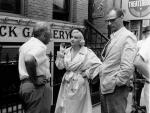


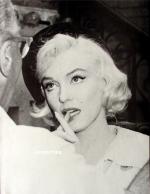
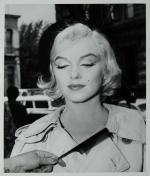
- Marilyn Monroe & Yves Montand -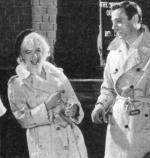
Sur le plateau
On the set
- Marilyn Monroe & boy scout -
(remise d'une médaille ? / awarded with a medal ?)


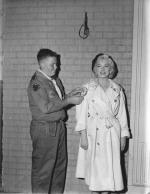

- Alan Whitey Snyder, Marilyn Monroe & des personnes de l'équipe du film -
Alan Whitey Snyder, Marilyn & members of the crew of the movie 
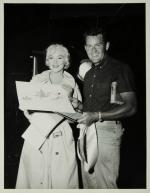

Dans la loge
In her dressing-room
- photographies: Lawrence Schiller -
- Marilyn Monroe & Yves Montand - 

- photographies: Robert Vose -
© All images are copyright and protected by their respective owners, assignees or others.
copyright text by GinieLand.